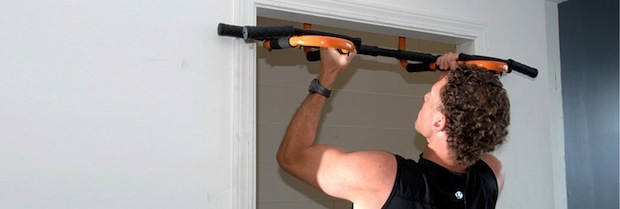Most people view Pull Ups as an exercise that only the very strong and athletic can successfully accomplish. Because of this, some will never even attempt one for fear of looking weak or foolish, and many of those who do try will give up early on because of frustration with how hard it can be to pull off even one properly executed Pull Up. The thing is, Pull Ups and Chin Ups are arguably the key exercises to build upper body strength, and are easier to successfully achieve than one may think.
These exercise help to not only build muscles throughout the entire back, but also help strengthen your grip, hands, forearms, biceps, triceps and shoulders, as well as your core/abs due to the core stabilization needed to perform the exercises.
As with anything else in life worth doing, achieving a properly executed Pull Up takes patience and practice. By following the techniques and tips below you will master the Pull Up and Chin Up with ease – and get results FAST!
Doing them right will get you better results!
Here are 10 ways to improve your Pull Ups and Chin Ups.
1- Start it off Right
To ensures that the exercise targets the muscles and not the tendons and ligaments, one shouldn’t be “just hanging there” at the start of the exercise. Roll your shoulders back and down, pull your shoulder blades down, and pull your shoulders down – don’t let the shoulders come up to the ears.
2- It’s all about the Lats
Your lat muscles should be doing most of the work. Many beginners will put too much stress on the biceps. When pulling up, remember to drive your elbows back and down. As a beginner, it can help to have someone keep their hands on your lats throughout your set in order to keep your focus on them.
3- Slightly bend the Elbows
On each rep you should lower yourself until your arms are ALMOST completely straight; maintaining a tiny, barely noticeable bend at the elbows. This bend will keep the stress on the muscles and off the tendons, ligaments, and elbow joints.
4- Go All the Way… Down
Don’t cheat by not going all the way down in the lowering part of your Pull Up and Chin Up (except for the slight bend mentioned above of course) Not going all the way down puts the target area of the exercise on your upper arms as oppose to your upper back. This mistake is one of the main reasons why people fail to see the full benefits of these exercises. You will never see the results you’re working so hard for if you don’t do the exercise right.
5- Chin Only
To achieve results one only needs their chin to clear the bar. Keeping your back arched, get your chin over the bar, and then lower yourself. Pushing yourself to pull up further wastes precious energy, and takes the target area off your lats.
6- Don’t go to Failure
Going to failure is the biggest mistake you can make with Pull Ups and Chin Ups, because once you get too tired you lose technique/proper positioning, which results in putting the stress of the exercise on undesired parts of the body (i.e.. joints, tendons, ligaments) This will lead to failing to achieve desired results, and possible injury. As soon as you can’t maintain form and technique, you can’t get as high, or you slow down considerably, the set is over.
7- Use a Variety of Grips
Using different grip widths, different hand positioning, and a variety of equipment will help to eliminate the possibility of overuse injuries, and make you stronger. You can do Chin Ups with your palms facing you at a number of different grip widths. A good Chin Up bar with multiple grip options can be a great tool to help with this.
Get Astone’s Complete Chinup Bar for $34.99!
You can Pull Up on bars, Olympic rings, ropes, beams, and suspension straps.
* We highly recommend Pull Ups on a suspension gym or rings because it allows for natural range of motion of the wrists, making the movement easier, and eliminating risk of joint injury.*
8- Change up your Reps
In order to build strength AND endurance one must remember that strength is obtained with low reps, and endurance with high reps. To get the most out of your workout it is best to change up your routine and sometimes do high reps, and sometimes low reps.
Add more of a challenge to your low-rep days by using a weighted vest or dip belt. Resistance Bands are great tools to help you successfully achieve more reps on your high-rep days. Attach a resistance band to your pull up bar and loop it around your knee or foot. Having a variety of band tensions available to you will allow you to vary your rep range greatly.
9- Strengthen Your Grip
The stronger your grip is the easier it will be to pull off Pull Ups and Chin Ups. You’ll never be good at these exercises if you can’t hold on long enough. Train by simply hanging off the bar with two arms, and as you get stronger try with one arm at a time. Also try Barbell holds with heavy weights. Strengthen your forearms and wrists with reverse bar curls, wrist curls, reverse wrist curls, and pinch gripping (holding two weight plates together and lifting them with one hand)
10- Lose Weight
If you are overweight you will definitely have a harder time getting your body up over that bar. Lose the unwanted pounds and of course, Pull Ups and Chin Ups will be easier.
Tips for Beginners:
Stay Off the Machines. Machines are like a crutch because they balance the weight for you and force you into fixed motion. You won’t get anywhere near the same results as with a regular old Pull Up.
Use Resistance Bands. Using resistance bands will give you a bit of a boost until you gain strength and can do it without them. Unlike Pull Up Machines, resistance bands only help you in the bottom position by giving you a little push on your way; not throughout the entire movement. You still do all the work at the top of the movement.
Get Help. Workout with a buddy and get them to grab you by your waist and help you on the way up.
Start with Chin Ups. Chin Ups are easier to do than Pull Ups. Starting with Chin Ups will help strengthen your grip, and get your body prepped for Pull Ups. Once you can do 5 reps with proper technique switch to Pull Ups. You should be able to do at least 1 rep at this point. (use a resistance band to start with Pull Ups)
ONCE YOU ARE ABLE TO DO AT LEAST 1 PULLUP
The best way to increase your Pull Up reps is to keep doing them. Even if you can only do one properly, start with 10 sets of 1, spreading out the sets as much as you can. I tried this by hanging a Pull Up bar in my doorway. Every time I passed under that bar, I’d do one Pull Up.
When 10 sets of 1 gets easy, switch to 10 sets of 2. Continue adding reps to your sets until you can do 10 sets of 5 Pull Ups.
Once you can do 10 sets of 5, you’ll be able to do 10 Pull ups on your 1st set.
With these tips you don’t have anymore excuses as to why you can’t do a Pull Up. Just have patiences with yourself. There’s no failing as long as you keep at it.
Sources: jasonferruggia.com, stronglifts.com, www.megliofitness.com, www.extremepullups.com, www.alkavadlo.com






 Payments powered by:
Payments powered by:

